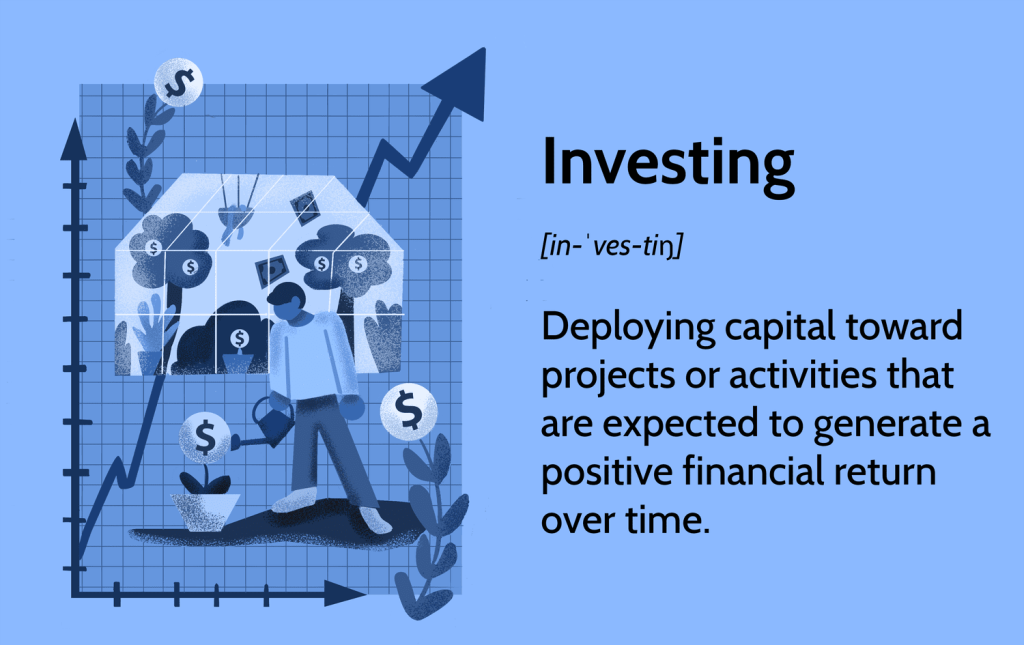What is Investing? A Beginner’s Guide to Building Wealth
Investing: it’s a term that often swirls around the financial world, leaving many individuals perplexed and uncertain about its true meaning. For those eager to embark on a journey towards financial growth, understanding what investing entails is crucial. In this article, we will demystify the concept of investing, exploring its core principles, potential benefits, and offering practical guidance to help you get started.

Investing 101: Laying the Foundation
Before diving into the depths of investing, let’s establish a solid foundation by answering the fundamental question: What is investing?
Investing, in its simplest form, is the art of putting your money to work with the aim of generating profits or achieving long-term financial goals. Rather than letting your hard-earned cash idly sit in a savings account, investing allows you to allocate your funds into various assets, such as stocks, bonds, real estate, or mutual funds, which have the potential to appreciate in value over time.
The Power of Compound Interest: Making Money Work for You
One of the key reasons why investing is often considered a prudent financial strategy is the concept of compound interest. By reinvesting the returns earned from your initial investments, you can generate additional income, creating a snowball effect of wealth accumulation.
To illustrate the power of compound interest, let’s consider an example: Imagine investing $1,000 in a stock that yields an average annual return of 8%. Over time, your investment would grow, not just by $80 annually, but by a compounding amount that includes the initial investment, the returns, and the reinvested profits. As the years pass, your investment can grow exponentially, helping you achieve your financial aspirations.
Navigating Risk and Reward: The Balancing Act
While investing offers the potential for financial growth, it’s crucial to recognize that it also comes with an inherent level of risk. The investment landscape can be unpredictable, influenced by a variety of factors such as economic conditions, market fluctuations, and even global events.
As an investor, understanding the concept of risk-reward tradeoff is paramount. Typically, higher potential returns are associated with higher levels of risk. It’s important to strike a balance between seeking growth opportunities and mitigating risks by diversifying your investment portfolio. By spreading your investments across different asset classes, industries, and geographic regions, you can potentially reduce the impact of any single investment’s performance on your overall portfolio.
Getting Started: A Roadmap to Investment Success
Now that we’ve explored the essence of investing, you may be wondering how to get started on your investment journey. Here are a few essential steps to help set you on the right path:
- Set Clear Financial Goals: Determine what you hope to achieve through investing. Whether it’s saving for retirement, buying a home, or funding your child’s education, having specific goals will guide your investment decisions.
- Educate Yourself: Take the time to learn about different investment options and strategies. Read books, follow reputable financial news outlets, and consider seeking advice from certified financial professionals who can offer personalized guidance.
- Define Your Risk Tolerance: Assess your comfort level with risk and establish an investment strategy that aligns with your risk tolerance. Understand that investing involves potential fluctuations in value, and be prepared to weather short-term market volatility for long-term gains.
- Build a Diversified Portfolio: As mentioned earlier, diversification is crucial for managing risk. Invest in a mix of assets that have the potential to perform differently under various market conditions.
- Stay the Course: Investing is a long-term endeavor, and it’s important to remain disciplined and avoid impulsive reactions to short-term market movements. Remember, the key to successful investing lies in patience, consistency, and periodic portfolio reviews.
Conclusion
Investing can be an exciting and rewarding journey that empowers you to grow your wealth and achieve your financial aspirations. By understanding the fundamental principles of investing, embracing the power of compound interest, and adopting a disciplined approach, you can navigate the investment landscape with confidence. Remember, building wealth through investing is a marathon, not a sprint, and with perseverance and knowledge, you can pave the way towards a prosperous financial future.

